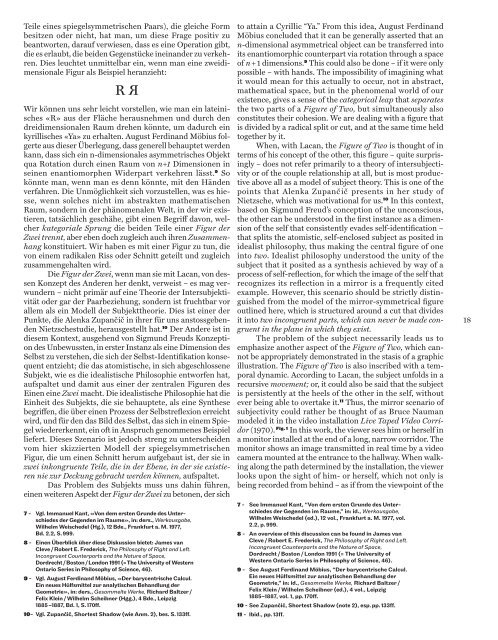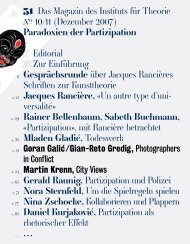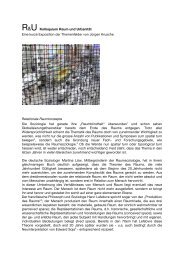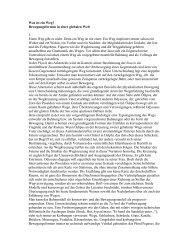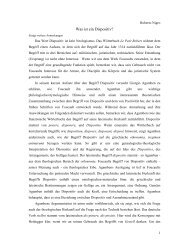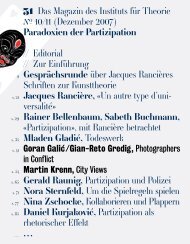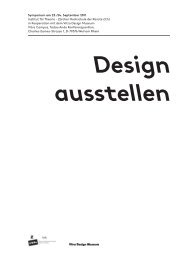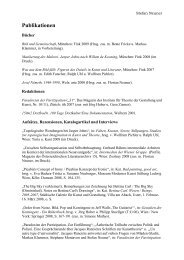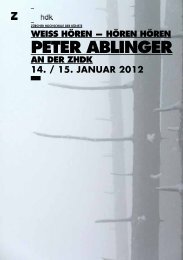Heft - Institut für Theorie ith
Heft - Institut für Theorie ith
Heft - Institut für Theorie ith
Sie wollen auch ein ePaper? Erhöhen Sie die Reichweite Ihrer Titel.
YUMPU macht aus Druck-PDFs automatisch weboptimierte ePaper, die Google liebt.
Teile eines spiegelsymmetrischen Paars), die gleiche Form<br />
besitzen oder nicht, hat man, um diese Frage positiv zu<br />
beantworten, darauf verwiesen, dass es eine Operation gibt,<br />
die es erlaubt, die beiden Gegenstücke ineinander zu verkehren.<br />
Dies leuchtet unmittelbar ein, wenn man eine zweidimensionale<br />
Figur als Beispiel heranzieht:<br />
Wir können uns sehr leicht vorstellen, wie man ein lateinisches<br />
«R» aus der Fläche herausnehmen und durch den<br />
dreidimensionalen Raum drehen könnte, um dadurch ein<br />
kyrillisches «Ya» zu erhalten. August Ferdinand Möbius folgerte<br />
aus dieser Überlegung, dass generell behauptet werden<br />
kann, dass sich ein n-dimensionales asymmetrisches Objekt<br />
qua Rotation durch einen Raum von n+1 Dimensionen in<br />
seinen enantiomorphen Widerpart verkehren lässt. 9 So<br />
könnte man, wenn man es denn könnte, mit den Händen<br />
verfahren. Die Unmöglichkeit sich vorzustellen, was es hiesse,<br />
wenn solches nicht im abstrakten mathematischen<br />
Raum, sondern in der phänomenalen Welt, in der wir existieren,<br />
tatsächlich geschähe, gibt einen Begri≠ davon, welcher<br />
kategoriale Sprung die beiden Teile einer Figur der<br />
Zwei trennt, aber eben doch zugleich auch ihren Zusammenhang<br />
konstituiert. Wir haben es mit einer Figur zu tun, die<br />
von einem radikalen Riss oder Schnitt geteilt und zugleich<br />
zusammengehalten wird.<br />
Die Figur der Zwei, wenn man sie mit Lacan, von dessen<br />
Konzept des Anderen her denkt, verweist – es mag verwundern<br />
– nicht primär auf eine <strong>Theorie</strong> der Intersubjektivität<br />
oder gar der Paarbeziehung, sondern ist fruchtbar vor<br />
allem als ein Modell der Subjekttheorie. Dies ist einer der<br />
Punkte, die Alenka Zupančič in ihrer <strong>für</strong> uns anstossgebenden<br />
Nietzschestudie, herausgestellt hat. 10 Der Andere ist in<br />
diesem Kontext, ausgehend von Sigmund Freuds Konzeption<br />
des Unbewussten, in erster Instanz als eine Dimension des<br />
Selbst zu verstehen, die sich der Selbst-Identifikation konsequent<br />
entzieht; die das atomistische, in sich abgeschlossene<br />
Subjekt, wie es die idealistische Philosophie entworfen hat,<br />
aufspaltet und damit aus einer der zentralen Figuren des<br />
Einen eine Zwei macht. Die idealistische Philosophie hat die<br />
Einheit des Subjekts, die sie behauptete, als eine Synthese<br />
begri≠en, die über einen Prozess der Selbstreflexion erreicht<br />
wird, und <strong>für</strong> den das Bild des Selbst, das sich in einem Spiegel<br />
wiedererkennt, ein oft in Anspruch genommenes Beispiel<br />
liefert. Dieses Szenario ist jedoch streng zu unterscheiden<br />
vom hier skizzierten Modell der spiegelsymmetrischen<br />
Figur, die um einen Schnitt herum aufgebaut ist, der sie in<br />
zwei inkongruente Teile, die in der Ebene, in der sie existieren<br />
nie zur Deckung gebracht werden können, aufspaltet.<br />
Das Problem des Subjekts muss uns dahin führen,<br />
einen weiteren Aspekt der Figur der Zwei zu betonen, der sich<br />
7 - Vgl. Immanuel Kant, «Von dem ersten Grunde des Unter -<br />
schiedes der Gegenden im Raume», in: ders., Werkausgabe,<br />
Wilhelm Weischedel (Hg.), 12 Bde., Frankfurt a. M. 1977,<br />
Bd. 2.2, S. 999.<br />
8 - Einen Überblick über diese Diskussion bietet: James van<br />
Cleve / Robert E. Frederick, The Philosophy of Right and Left.<br />
Incongruent Counterparts and the Nature of Space,<br />
Dordrecht / Boston / London 1991 (= The University of Western<br />
Ontario Series in Philosophy of Science, 46).<br />
9 - Vgl. August Ferdinand Möbius, «Der barycentrische Calcul.<br />
Ein neues Hülfsmittel zur analytischen Behandlung der<br />
Geometrie», in: ders., Gesammelte Werke, Richard Baltzer /<br />
Felix Klein / Wilhelm Scheibner (Hgg.), 4 Bde., Leipzig<br />
1885 –1887, Bd. 1, S. 170ff.<br />
10- Vgl. Zupančič, Shortest Shadow (wie Anm. 2), bes. S. 133ff.<br />
to attain a Cyrillic “Ya.” From this idea, August Ferdinand<br />
Möbius concluded that it can be generally asserted that an<br />
n-dimensional asymmetrical object can be transferred into<br />
its enantiomorphic counterpart via rotation through a space<br />
of n + 1 dimensions. 9 This could also be done – if it were only<br />
possible – w<strong>ith</strong> hands. The impossibility of imagining what<br />
it would mean for this actually to occur, not in abstract,<br />
mathematical space, but in the phenomenal world of our<br />
existence, gives a sense of the categorical leap that separates<br />
the two parts of a Figure of Two, but simultaneously also<br />
constitutes their cohesion. We are dealing w<strong>ith</strong> a figure that<br />
is divided by a radical split or cut, and at the same time held<br />
together by it.<br />
When, w<strong>ith</strong> Lacan, the Figure of Two is thought of in<br />
terms of his concept of the other, this figure – quite surprisingly<br />
– does not refer primarily to a theory of intersubjectivity<br />
or of the couple relationship at all, but is most productive<br />
above all as a model of subject theory. This is one of the<br />
points that Alenka Zupanč ič presents in her study of<br />
Nietzsche, which was motivational for us. 10 In this context,<br />
based on Sigmund Freud’s conception of the unconscious,<br />
the other can be understood in the first instance as a dimension<br />
of the self that consistently evades self-identification –<br />
that splits the atomistic, self-enclosed subject as posited in<br />
idealist philosophy, thus making the central figure of one<br />
into two. Idealist philosophy understood the unity of the<br />
subject that it posited as a synthesis achieved by way of a<br />
process of self-reflection, for which the image of the self that<br />
recognizes its reflection in a mirror is a frequently cited<br />
example. However, this scenario should be strictly distinguished<br />
from the model of the mirror-symmetrical figure<br />
outlined here, which is structured around a cut that divides<br />
it into two incongruent parts, which can never be made congruent<br />
in the plane in which they exist.<br />
The problem of the subject necessarily leads us to<br />
emphasize another aspect of the Figure of Two, which cannot<br />
be appropriately demonstrated in the stasis of a graphic<br />
illustration. The Figure of Two is also inscribed w<strong>ith</strong> a temporal<br />
dynamic. According to Lacan, the subject unfolds in a<br />
recursive movement; or, it could also be said that the subject<br />
is persistently at the heels of the other in the self, w<strong>ith</strong>out<br />
ever being able to overtake it. 11 Thus, the mirror scenario of<br />
subjectivity could rather be thought of as Bruce Nauman<br />
modeled it in the video installation Live Taped Video Corridor<br />
(1970). Fig. 1 In this work, the viewer sees him or herself in<br />
a monitor installed at the end of a long, narrow corridor. The<br />
monitor shows an image transmitted in real time by a video<br />
camera mounted at the entrance to the hallway. When walking<br />
along the path determined by the installation, the viewer<br />
looks upon the sight of him- or herself, which not only is<br />
being recorded from behind – as if from the viewpoint of the<br />
7 - See Immanuel Kant, “Von dem ersten Grunde des Unter -<br />
schiedes der Gegenden im Raume,” in: id., Werkausgabe,<br />
Wilhelm Weischedel (ed.), 12 vol., Frankfurt a. M. 1977, vol.<br />
2.2, p. 999.<br />
8 - An overview of this discussion can be found in James van<br />
Cleve / Robert E. Frederick, The Philosophy of Right and Left.<br />
Incongruent Counterparts and the Nature of Space,<br />
Dordrecht / Boston / London 1991 (= The University of<br />
Western Ontario Series in Philosophy of Science, 46).<br />
9 - See August Ferdinand Möbius, “Der barycentrische Calcul.<br />
Ein neues Hülfsmittel zur analytischen Behandlung der<br />
Geometrie,” in: id., Gesammelte Werke, Richard Baltzer /<br />
Felix Klein / Wilhelm Scheibner (ed.), 4 vol., Leipzig<br />
1885–1887, vol. 1, pp. 170ff.<br />
10 - See Zupančič, Shortest Shadow (note 2), esp. pp. 133ff.<br />
11 - Ibid., pp. 13ff.<br />
18


